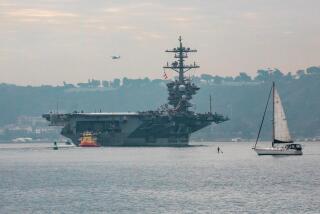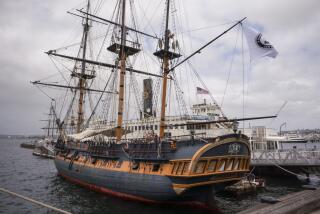Ensuring Port Safety, 1 Ship at a Time
Armed with pistols and batons, they set to sea before dawn on Sunday, boring in on a luxury cruise liner plying from Cabo San Lucas, and still about five miles beyond the Los Angeles harbor breakwater.
After matching speeds with the 70,300-ton Elation and nestling up against its starboard side, the six sea marshals jumped off their smaller craft and onto the cruise liner’s wobbly rope ladder--then advanced to prearranged positions and tasks.
“Don’t be complacent,” advised sea marshal team leader Richard Greenbauer. “Keep alert. Be safe.”
The mission of these U.S. Coast Guard reservists--a San Juan Capistrano city planner, a state Fish and Game Department officer, a UCLA drug abuse researcher, a Los Angeles County public safety officer, and two port police officers--was to ensure that there was no one on board with plans to turn the 2,040-passenger vessel into a massive battering ram, or floating bomb.
Their takeover was swift, efficient and friendly. But all were specially trained to, as one of them put it, “use deadly force, if it hits the fan.”
Since the Sept. 11 terrorist attacks, the mantra around the Los Angeles-Long Beach port complex, which is the nation’s busiest, has been simple: Leave nothing to chance.
Each year, the ports handle more than 1 million passengers, 5,500 commercial vessels and $170 billion of commerce. In addition, more than 272 million barrels of oil are loaded and offloaded annually.
Now, every incoming cruise liner and oil tanker--and most freighters--are boarded and examined miles from shore, then escorted into port by the newly formed corps of sea marshals trained to neutralize terrorists and weapons of mass destruction.
Boarding moving vessels on the high seas is dangerous work. In late November, a sea marshals’ craft capsized in the dark in heaving seas beside a cruise liner about 10 miles beyond the local breakwater, spilling five officers into the water. All were rescued, including a woman trapped beneath the topsy-turvy boat.
In late October, a Coast Guard officer preparing to step off his cutter and onto a vessel in the San Francisco Bay was seriously bruised when his leg was caught between the ships.
Despite an oncoming storm, the boarding of the Carnival Corp.’s Elation at 5:30 a.m. on Sunday went without a hitch.
Sea marshal team leader Greenbauer greeted the Elation’s captain and examined the vessel’s manifests. Amber Horning stood guard in the pilot house.
Four others roamed the ship’s elegant interior for signs of anything out of the ordinary, including odd behavior by the crew or passengers.
They inspected the baggage room and kitchen, strode through neon-lit halls and cabaret lounges, and peeked inside life boats and bathrooms, under desks and machinery, even inside fire extinguisher boxes.
Marching into the engine control room--a brightly lit compartment crammed with dials, gauges, computer screens, clocks and wall-sized schematics of the ship and its hundreds of cabins, sea marshal Dennis Chastain asked, “How’s the trip been? Everything OK here?”
Two crew members, surprised by the armed visitors, nodded in the affirmative and returned to their computer screens.
All told, the ship was declared secure and safe within 30 minutes.
Shortly after docking in San Pedro at about 7 a.m., Elation Capt. Alessandro Gelotto, said, “We have our own security force. But I’m delighted with the sea marshals. We feel safer having them on board.”
Passenger Larry Burnside, a log cabin builder from Marion, Ind., was more blunt.
Drinking a cup of coffee on the top deck, he smiled and said, “First thing I saw this morning were fellas with pistols on their hips, and man, I was glad to see them. Tickled to death.”
Vacationing airline pilot Mike Magras, of Tucson, agreed, to a point.
“I wonder how effective a handful of agents can be inspecting a ship of this size,” he said. “It’s got an unimaginable number of places to hide.”
Then there was hairdresser Lynda Renner of Minneapolis, who insisted that a pair of sea marshals pose for a snapshot as the cruise liner slid past the Vincent Thomas Bridge.
“I wouldn’t know what a bomb even looks like,” she said. “So I’m glad there’s guys coming up to make sure we’re not going to be used by someone out to make international news.”
More to Read
Sign up for The Wild
We’ll help you find the best places to hike, bike and run, as well as the perfect silent spots for meditation and yoga.
You may occasionally receive promotional content from the Los Angeles Times.







